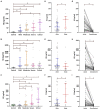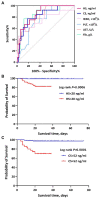High levels of exfoliated fragments following glycocalyx destruction in hemorrhagic fever with the renal syndrome are associated with mortality risk
- PMID: 37138736
- PMCID: PMC10149802
- DOI: 10.3389/fmed.2023.1096353
High levels of exfoliated fragments following glycocalyx destruction in hemorrhagic fever with the renal syndrome are associated with mortality risk
Abstract
Background: The glycocalyx is a gel-like structure that covers the luminal side of vascular endothelial cells. It plays an important role in maintaining the integrity of the vascular endothelial barrier structure. However, the presence or absence of glycocalyx destruction in hemorrhagic fever with renal syndrome (HFRS) and its specific mechanism and role is still unclear.
Methods: In this study, we detected the levels of exfoliated glycocalyx fragments, namely, heparan sulfate (HS), hyaluronic acid (HA), and chondroitin sulfate (CS), in HFRS patients and investigated their clinical application value on the evaluation of disease severity and prognosis prediction.
Results: The expression of exfoliated glycocalyx fragments in plasma was significantly increased during the acute stage of HFRS. The levels of HS, HA, and CS in HFRS patients during the acute stage were significantly higher than in healthy controls and convalescent stages of the same type. HS and CS during the acute stage gradually increased with the aggravation of HFRS, and both fragments showed a significant association with disease severity. In addition, exfoliated glycocalyx fragments (especially HS and CS) showed a significant correlation with conventional laboratory parameters and hospitalization days. High levels of HS and CS during the acute phase were significantly associated with patient mortality and demonstrated an obvious predictive value for the mortality risk of HFRS.
Conclusion: Glycocalyx destruction and shedding may be closely associated with endothelial hyperpermeability and microvascular leakage in HFRS. The dynamic detection of the exfoliated glycocalyx fragments may be beneficial for the evaluation of disease severity and prognosis prediction in HFRS.
Keywords: chondroitin sulfate; glycocalyx; hemorrhagic fever with renal syndrome; heparan sulfate; hyaluronic acid.
Copyright © 2023 Du, Hu, Li, Wang, Jiang, Lian, Zhang and Wang.
Conflict of interest statement
The authors declare that the research was conducted in the absence of any commercial or financial relationships that could be construed as a potential conflict of interest. The reviewer ZS declared a shared parent affiliation with the Authors to the Handling editor at the time of review.
Figures



Similar articles
-
Predictive value of pentraxin-3 on disease severity and mortality risk in patients with hemorrhagic fever with renal syndrome.BMC Infect Dis. 2021 May 17;21(1):445. doi: 10.1186/s12879-021-06145-0. BMC Infect Dis. 2021. PMID: 34001041 Free PMC article.
-
Study on expression of plasma sCD138 in patients with hemorrhagic fever with renal syndrome.BMC Infect Dis. 2018 Mar 1;18(1):100. doi: 10.1186/s12879-018-3005-0. BMC Infect Dis. 2018. PMID: 29490629 Free PMC article.
-
Endothelial glycocalyx shedding and vascular permeability in severely injured trauma patients.J Transl Med. 2015 Apr 12;13:117. doi: 10.1186/s12967-015-0481-5. J Transl Med. 2015. PMID: 25889764 Free PMC article.
-
Investigation of Endothelial Surface Glycocalyx Components and Ultrastructure by Single Molecule Localization Microscopy: Stochastic Optical Reconstruction Microscopy (STORM).Yale J Biol Med. 2018 Sep 21;91(3):257-266. eCollection 2018 Sep. Yale J Biol Med. 2018. PMID: 30258313 Free PMC article. Review.
-
Endothelial Glycocalyx Impairment in Disease: Focus on Hyaluronan Shedding.Am J Pathol. 2020 Apr;190(4):768-780. doi: 10.1016/j.ajpath.2019.11.016. Epub 2020 Feb 6. Am J Pathol. 2020. PMID: 32035885 Review.
Cited by
-
Levels of peripheral blood routine, biochemical and coagulation parameters in patients with hemorrhagic fever with renal syndrome and their relationship with prognosis: an observational cohort study.BMC Infect Dis. 2024 Jan 11;24(1):75. doi: 10.1186/s12879-023-08777-w. BMC Infect Dis. 2024. PMID: 38212688 Free PMC article.
-
Epidemiological and clinical characteristics of death from hemorrhagic fever with renal syndrome: a meta-analysis.Front Microbiol. 2024 Apr 4;15:1329683. doi: 10.3389/fmicb.2024.1329683. eCollection 2024. Front Microbiol. 2024. PMID: 38638893 Free PMC article.
-
Vascular dysfunction in hemorrhagic viral fevers: opportunities for organotypic modeling.Biofabrication. 2024 Jun 5;16(3):032008. doi: 10.1088/1758-5090/ad4c0b. Biofabrication. 2024. PMID: 38749416 Free PMC article. Review.
References
-
- Tian HY, Yu PB, Luis AD, Bi P, Cazelles B, Laine M, et al. . Changes in rodent abundance and weather conditions potentially drive hemorrhagic fever with renal syndrome outbreaks in Xi'an, China, 2005-2012. PLoS Negl Trop Dis. (2015) 9:e0003530. doi: 10.1371/journal.pntd.0003530, PMID: - DOI - PMC - PubMed
LinkOut - more resources
Full Text Sources

